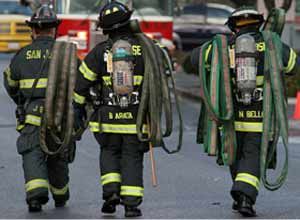By Cristi Laquer
FireRescue1 Staff
 Photo Craig Allyn Rose Leather turnout boots are becoming lighter and more comfortable as technology advances. |
Up until a few years ago, firefighting boots were often notoriously uncomfortable. The requirements that they be heat- and chemical-resistant traditionally made them heavy, hard to run in, and prone to slipping against the ground and the firefighter’s foot.
But technological advances over the past 15 years have enabled boot manufacturers to compete on the basis of comfort.
According to Mark Mordecai, director of business development for Globe Fire Suits, manufacturers are increasingly looking at leather options as they are usually more breathable than their rubber counterparts. “The industry is switching to technologies that are more like a regular boot,” he said.
Traditional choice
Rubber boots have been the traditional choice as they are cheaper to manufacture and automatically provide the chemical and liquid resistance required by NFPA standards.
But with the development of Crosstech® and other liquid-resistant fabrics, manufacturers such as Globe have taken advantage of the technology to use in leather boots to provide liquid protection and resistance to chemicals and blood and body fluids.
“The same thing that’s in PPE could be put inside leather boots, so leather boots could be made resistant,” said Mordecai.
However, manufacturers of rubber boots are also finding ways to reduce the weight of their products. Certain rubber formulations and the design features on rubber footwear can all help to reduce weight.
Boot outsoles
When it comes to the manufacturing of the outsoles of fire boots, along with military, work and even cowboy boots, a process called Goodyear Welt construction has long been used.
The Goodyear Welt Sewing Machine and process was invented in 1875 by Charles Goodyear, Jr., son of the famous inventor of a process for vulcanizing rubber.
According to boot construction experts, Goodyear Welt construction is the most durable outsole construction method. But a newer technology, cement construction, where the outsole is bonded to the leather upper by an adhesive, is both stronger and more comfortable, according to Mordecai.
“We use cement construction and it really is an athletic footwear platform,” he said. “Each layer can now be contoured. The heel is held back and down in the boot, and the whole sole can flex, instead of having a flat, stiff platform that doesn’t break in.”
Similar products
Globe’s FootGear line of boots is currently the only fire boot available to purchase with cement outsole construction, but other manufacturers have announced that they will soon be introducing similar products.
“There has been inertia in the market because the investment required for this kind of technology is very high,” Mordecai said. “Each component for each size of foot has to have a separate mold.”
The quintessential “steel toe” is also rapidly becoming a thing of the past in boot construction, according to Mordecai.
“We’ve gotten rid of all the steel components,” Mordecai said. “Everything is now advanced composites because they’re stronger and lighter than steel.”
Many fire boot manufacturers have already adopted composite materials to solve the problem of providing toe-impact protection, which is required by NFPA standards, without metal.
“Without metal parts, there are no electrical conductivity or heat and cold issues,” Mordecai said. “Especially in winter, if you have steel plates in your boots, they really retain the cold.”











